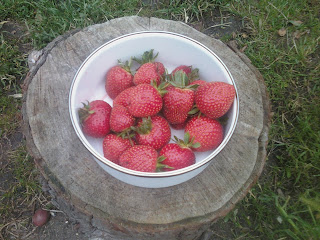One of the best things you can do as an organic gardener is to make compost. Compost is simply recycled organic waste. We have tried a few different composting techniques on site and have learnt alot about making your own compost. Compost can be made by simply adding organic material to a heap but it may take a long time and if the mix is unbalanced, the end product may not be very pleasant.
We built a large heap of garden waste and just let it sit. This heap consisted of mainly weeds, branches, grass cuttings and hedge clippings with some soil and organic fabrics. This system of composting is called Cool Heap Composting and usually takes a very long time to compost. We built our heap in 2009, and have just collected our first usable compost.
Cool compost heap
Once we removed the majority of un-decomposed larger material we were left with about ten inches of compost, enough to fill two wheel borrows. It was lovely compost, very rich in organic matter, dark in colour, crumbly and sweet smelling. The larger organic material which were not able to be fully decomposed would be shredded and added to another composting system.
Ready to use home-made sieved compost
Another method of composting we have tried is the hot bed/heap composting system. This involved digging out a hole in the ground and filling it with lots of alternating layers of brown material and green material (explained later). We first added a small layer of wood/paper ash and then added all the organic material. We made an effort to chop up all the material to allow the micro-organisms, which would be doing the composting, more surface areas to work on. For this we used a simple garden spade.
Layering and chopping the material
For the hot bed method we added a layer of fresh horse manure (high in both brown and green material) and a bit of Netfrey tea fertilizer, just to help get things moving along.
Home-made fertilizer (not much needed)
The finished bed was then covered and would not be disturbed for at least one (1) month, at which time the heap will be turned/mixed and then left to mature. This system would normally take anywhere from six (6) months up to a year, and the results are always amazing.
The completed heap
It is important to note that if you are going to be using this method of composting that there is a hole in the ground and it could be very dangerous, especially at night, therefore it is advisable to cover the heap with a hard surface, we used a strong wooden pallet which also makes a very good work surface, and helps reduse the amount of rain getting into the heap.
Willow cuttings on hot compost bed
This system can also be done using a conventional compost bin. So instead of using a dug out hole, you would build up the layers in a compost bin and let mature for a few months. If the hot composting system is used in a bin it can take less time till the compost is ready for use, if managed properly. We have collected some compost from the last hot bed we made in late October and it was very good compost.
Eight (8) months of composting (turned twice)
Green & Brown
When it comes to composting it is important to get the mix of brown and green material right. Brown materials are those high in carbon:
- Corn cobs and stalks.
- Eggs shells.
- Feathers.
- Cardboard Cereal and egg boxes.
- Corrugated cardboard packing.
- Newspapers (not glossy magazines).
- Toilet and kitchen roll tubes.
- Tissues, paper towelling and napkins (make sure they are not contaminated with meat, fats, oils or disease).
- Natural fibre string.
- Shredded plain paper.
- Young wood garden prunings.
- Dry leaves, small twigs and most hedge cuttings.
- Hay and Straw.
- Ash from wood or paper fires.
- Sawdust.
- Pine needles and cones.
Too much of brown material would greatly slow down the composting process and will give you an end product very high in carbon and lacking other minerals, but too much green material will result in bad smelling soggy compost. Green materials are those high in nitrogen:
- Vegetable peelings.
- Salad waste.
- Fruit waste i.e. apple cores, skins etc. - includes citrus fruit.
- Used tea bags/leaves.
- Used coffee grounds and filter paper.
- Dead flowers and house plants.
- Grass cuttings.
- Old flowers.
- Old bedding plants.
- Nettle.
- Rhubarb leaves.
- Comfrey leaves.
- Young annual weeds.
- Pond weed.
- Seaweed - watch out for oil contamination etc.
I would suggest getting a balanced heap of around 1:1 of green and brown material.
It is important to protect your composting systems from the elements but it is also as equally important to keep it aerated. The flow of air helps keep the heaps from producing bad smells. You should also try to minimise the amount of larger bits of material added to your system. The compost makers (microbes, worms, bacteria, woodlice, etc.) will work better and faster when they have more surface area to work on. The smaller the bits of organic matter added to a composting system the more surface area is available to the compost workers. However some larger bits are required to help aid air flow through the heap.
Our newly built compost bin.
I believe that you get the best result from composting when you fill up your composting system in one go and leave it to mature, turning once in a while. I believe that once the heap is built nothing else should be added to it and all other composting material should be stored in separate bins. At May Project Gardens we now have a large bin for the storing of brown material, smaller bins for collecting green material, a bin where the actual composting heap will be built, and we also have a small wormery which is very productive. Composting is a fantastic way of recycling organic waste and is not only useful to gardeners but fun too. Making your own compost saves you money and helps the environment and there is no better feel than producing your very own healthy organic soil from 'waste'.































